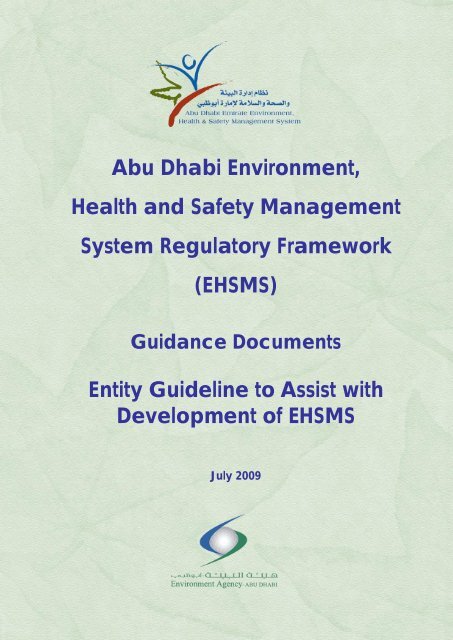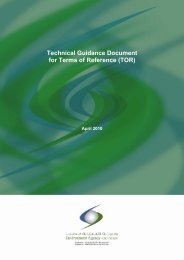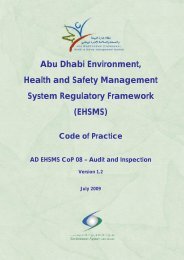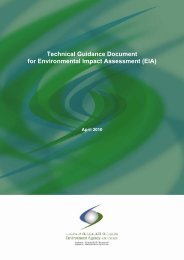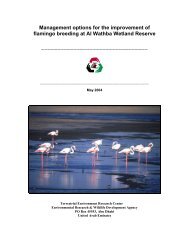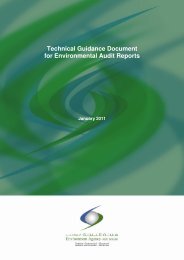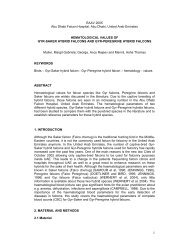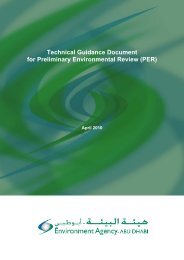Abu Dhabi Environment, Health and Safety Management System ...
Abu Dhabi Environment, Health and Safety Management System ...
Abu Dhabi Environment, Health and Safety Management System ...
You also want an ePaper? Increase the reach of your titles
YUMPU automatically turns print PDFs into web optimized ePapers that Google loves.
<strong>Abu</strong> <strong>Dhabi</strong> <strong>Environment</strong>,<strong>Health</strong> <strong>and</strong> <strong>Safety</strong> <strong>Management</strong><strong>System</strong> Regulatory Framework(EHSMS)Guidance DocumentsEntity Guideline to Assist withDevelopment of EHSMSJuly 2009
Contents1. Introduction 11.1 Background 11.2 Purpose of Guideline 11.3 Entities with International Certification 22. <strong>Management</strong> Commitment 42.1 Establishment of an EHS <strong>Management</strong> Committee 42.2 Development of Policy 43. Planning 53.1 Identify EHS Risks 53.2 Identify Legal Requirements 53.3 Develop EHSMS Targets <strong>and</strong> Key Performance Indicators 63.4 Developing an EHS <strong>Management</strong> Program 74. Implementation <strong>and</strong> Operations 94.1 Identify Roles <strong>and</strong> Responsibilities 94.2 Identify Training Needs 114.3 Develop EHS Policies <strong>and</strong> Procedures 124.4 Develop Document Control Procedures 124.5 Emergency <strong>Management</strong> 134.6 Communicate to Staff 145. Check <strong>and</strong> Corrective Action 155.1 Monitor, Measure, <strong>and</strong> Report 155.2 External Reporting 155.3 Internal EHSMS Auditing 165.4 External EHSMS Auditing 165.5 Non-Conformance <strong>and</strong> Corrective <strong>and</strong> Preventative Action 175.6 Records <strong>Management</strong> 196. <strong>Management</strong> Review 207. Approval of EHSMS 218. Special Provisions for Entities with Established <strong>System</strong>s 22
Table IndexTable 1Federal <strong>and</strong> <strong>Abu</strong> <strong>Dhabi</strong> Emirate LegalRequirements 5Figure IndexFigure 1Figure 2Roadmap for Successful <strong>Environment</strong>al <strong>Health</strong> <strong>and</strong><strong>Safety</strong> <strong>Management</strong> <strong>System</strong> Implementation 3Non-Conformance <strong>and</strong> Corrective Action PlanDecision Making Tool 18
1. Introduction1.1 BackgroundOn 6 th December 2006, the Executive Council issued a Decree (Committee Decree 2-Session 31/2006) approving "<strong>Abu</strong> <strong>Dhabi</strong> Emirate EHS policy" <strong>and</strong> nominated the<strong>Environment</strong> Agency–<strong>Abu</strong> <strong>Dhabi</strong> (EAD) as the Authority responsible for supervising theimplementation of the EHS <strong>Management</strong> <strong>System</strong> (EHSMS) at <strong>Abu</strong> <strong>Dhabi</strong> Emirate levelin cooperation <strong>and</strong> coordination with all concerned parties.The objective of the policy is to achieve excellence in the management <strong>and</strong> protectionof the environment, health, <strong>and</strong> safety through partnership between all government <strong>and</strong>private sectors to ensure activities within <strong>Abu</strong> <strong>Dhabi</strong> Emirate are undertaken in aresponsible, safe, <strong>and</strong> sustainable manner.To follow up the development <strong>and</strong> implementation of the <strong>Abu</strong> <strong>Dhabi</strong> Emirate EHSMSFramework, the Executive Council established the "EHS Higher Committee" by aDecree issued on 11 th June 2007.1.2 Purpose of GuidelineThis report is a guideline that provides an overview of the steps that need to beundertaken by an entity to develop its own EHSMS. A full training program has alsobeen developed within <strong>Abu</strong> <strong>Dhabi</strong> Emirate EHSMS framework to help entities establishtheir own EHSMS. This guideline is a summary of that training program.Generally, the steps to develop an EHSMS fall into five main categories:1. <strong>Management</strong> commitment;2. Planning;3. Implementation <strong>and</strong> operations;4. Checking <strong>and</strong> corrective action; <strong>and</strong>5. <strong>Management</strong> review <strong>and</strong> approval.This report assumes that entities using this guideline have not previously developed amanagement system based on international st<strong>and</strong>ards such as ISO 14001, ISO 9000or, OHSAS 18001. Thus, the report provides a step-by-step breakdown of the keytasks that need to be completed to develop <strong>and</strong> implement an EHSMS.This report outlines the steps that can be undertaken by entities to develop <strong>and</strong>implement an entity-specific EHSMS. The Emirate EHSMS Framework Codes ofPractice (CoPs) provide clear guidance on how entities can develop their own systemswithin the required EHSMS framework.Figure 1 outlines the necessary steps which will be explained in more detail in thereport. These steps are based on the International St<strong>and</strong>ards Organisation (ISO)st<strong>and</strong>ards while also outlining <strong>Abu</strong> <strong>Dhabi</strong> Emirate EHSMS specific requirements.76/10169/10/5953 Implementation of <strong>Abu</strong> <strong>Dhabi</strong> EHSMSEntity Guideline to Assist with Development of EHS <strong>Management</strong> <strong>System</strong>1
In addition to these steps, the <strong>Abu</strong> <strong>Dhabi</strong> Emirate EHSMS has the followingrequirements:All entities are required to register their EHSMS or their intent to develop anEHSMS to their Sector Regulatory Authority;Once the systems have been integrated <strong>and</strong> an EHSMS established, this mustbe submitted to the Sector Regulatory Authority for approval;Entities whose EHSMS have been approved must report quarterly or annuallyto their Sector Regulatory Authority. This will likely form a condition of a licenceto operate; <strong>and</strong> Entities with established EHSMS must conduct ongoing audit <strong>and</strong> inspectionswhich is an essential part of the self-regulation framework established by theEmirate EHSMS.1.3 Entities with International CertificationIf an entity has an existing system certified under ISO 14001, OHSAS 18001, or ISO9000, then many of the requirements outlined in this report will have been metalthough they will be specific to either environment, health <strong>and</strong> safety, or quality.If an entity has certification under any of these three international st<strong>and</strong>ards, then workwill be required to update the procedures to integrate environment <strong>and</strong> health <strong>and</strong>safety.A separate report (<strong>Abu</strong> <strong>Dhabi</strong> Emirate EHSMS Guidance Documents– Comparisonwith International <strong>Management</strong> <strong>System</strong>s St<strong>and</strong>ards) describes the relationshipbetween the elements of the international st<strong>and</strong>ards <strong>and</strong> the requirements of <strong>Abu</strong><strong>Dhabi</strong> Emirate EHSMS Framework.Entities with existing certified systems should refer to the Comparison report <strong>and</strong>Section 8 of this report for further guidance.76/10169/10/5953 Implementation of <strong>Abu</strong> <strong>Dhabi</strong> EHSMSEntity Guideline to Assist with Development of EHS <strong>Management</strong> <strong>System</strong>2
Figure 1Roadmap for Successful <strong>Environment</strong>al <strong>Health</strong> <strong>and</strong> <strong>Safety</strong> <strong>Management</strong> <strong>System</strong>ImplementationContinualImprovementComplianceGoals <strong>and</strong>PoliciesEstablish EHSMS Committee<strong>Management</strong> Commitment to EHSMSDevelop EHSMS PolicyDocument EHSMSPolicyEstablish procedure toidentify EHSMS risksImplementationScheduleIdentify EHSMS RisksReview Legal RequirementsEstablish procedure toaccess current <strong>and</strong>future legalrequirementsIdentify EHSMS targets <strong>and</strong> KPIsTrain staff in operations withsignificant impactsDevelop EHS <strong>Management</strong> ProgramIdentify Roles <strong>and</strong> ResponsibilitiesIdentify training needsEstablish document control proceduresDocument objectives<strong>and</strong> targetsDocument roles <strong>and</strong>responsibilitiesEHSMS awareness trainingWebsiteEmergency managementEmailsNewslettersCommunicate to staffBulletin boardsMeetingsMonitor, measure & reportPostersEHSMS –AuditingDocument findingsReturn To Top ForContinualImprovementCycle<strong>Management</strong> ReviewSector Regulatory AuthorityApprovalEstablish procedures formanaging non-conformanceDocument alldecisions <strong>and</strong>actionsKey:Step 1: <strong>Management</strong> commitmentStep 2: PlanningStep 3: Implementation <strong>and</strong> operationsStep 4: Checking <strong>and</strong> corrective actionStep 5: <strong>Management</strong> review76/10169/10/5953 Implementation of <strong>Abu</strong> <strong>Dhabi</strong> EHSMSEntity Guideline to Assist with Development of EHS <strong>Management</strong> <strong>System</strong>3
2. <strong>Management</strong> Commitment2.1 Establishment of an EHS <strong>Management</strong> CommitteeEstablishing an EHS <strong>Management</strong> Committee is an important first step when introducing an EHSMS intoan entity.The role of the Committee will be to facilitate implementation of the EHSMS, provide direction for thedevelopment of policies <strong>and</strong> procedures, act on behalf of management, <strong>and</strong> report to management.The EHS Committee usually includes representatives from staff, management, environment officers, <strong>and</strong>health <strong>and</strong> safety officers.For organisations with less than 50 employees the committee may comprise only the CEO (or a seniormanager) <strong>and</strong> an EHS Officer.2.2 Development of PolicyOne of the first steps that are to be undertaken in the development of an EHSMS is the development of aPolicy. The development <strong>and</strong> endorsement of an EHS Policy by management is an important way ofdemonstrating management commitment to the development <strong>and</strong> implementation of an EHSMS. Thepolicy should be short <strong>and</strong> concise. It can be supplemented with an explanatory booklet for personnel toenhance their underst<strong>and</strong>ing.Generally, there are 10 components that should be included in an EHS Policy:1. Statement of commitment of the entity to protect environment <strong>and</strong> health <strong>and</strong> safety usingEHSMS <strong>and</strong> self-regulation;2. Roles <strong>and</strong> responsibilities of management <strong>and</strong> workers in EHS;3. Establishment of a set of guiding principles:- Based on the principles of self-regulation <strong>and</strong> continual improvement- Based on the principles of ecologically sustainable development (integrating social,economic, <strong>and</strong> environmental spheres of development)- Adopting the precautionary principle- Risk management4. Development of EHS goals <strong>and</strong> targets;5. Requirement to meet regulatory requirements;6. Statement regarding achievement of a high level of environmental <strong>and</strong> health <strong>and</strong> safetystewardship;7. Statement extending responsibility of implementation of EHSMS to contractors;8. Provision of education opportunities in EHS;9. Monitoring EHSMS performance; <strong>and</strong>10. Provision for continuous improvement.76/10169/10/5953 Implementation of <strong>Abu</strong> <strong>Dhabi</strong> EHSMSEntity Guideline to Assist with Development of EHS <strong>Management</strong> <strong>System</strong>- 4 -
3. Planning3.1 Identify EHS RisksThe development of an entity-specific EHSMS begins with identifying key environmental <strong>and</strong> health <strong>and</strong>safety risks. The risks should relate to impacts from the entity’s activities in the day-to-day operations ofthe entity <strong>and</strong> reputation risk.One of the guiding principles in the EHS policy is to integrate economic, social, <strong>and</strong> environmentalconsiderations into decisions to ensure that the measures adopted are cost-effective <strong>and</strong> in proportion tothe significance of the issues being addressed. Therefore, to fully underst<strong>and</strong> the cost <strong>and</strong> effort requiredfor activities undertaken by an entity, a risk assessment must be completed.The <strong>Abu</strong> <strong>Dhabi</strong> EHSMS Manual includes a AD EHSMS CoP 05 - Risk <strong>Management</strong>. This can be used togain further underst<strong>and</strong>ing into ways to undertake a risk assessment.Once all risks have been identified, they need to be prioritised. This should be done by analysing thelikelihood of that incident occurring.Identification of an entity’s EHS risks is part of developing an EHS aspects register.3.2 Identify Legal RequirementsPart of managing EHS risks is to identify the legal requirements that apply to environment, health, <strong>and</strong>safety. As a guide, the current relevant UAE Federal <strong>and</strong> <strong>Abu</strong> <strong>Dhabi</strong> Emirate legislation is outlined inTable 1.It is recommended that all entities undertake their own internal review of legislation.Table 1Federal <strong>and</strong> <strong>Abu</strong> <strong>Dhabi</strong> Emirate Legal Requirements<strong>Environment</strong>al LegislationFederal Law No. 24, 1999 - This law outlinesways to achieve sound environmentalmanagement <strong>and</strong> sustainability through theestablishment <strong>and</strong> enhancement of suitablemanagement, legal, <strong>and</strong> technical instruments toprotect, develop, <strong>and</strong> conserve the environmentin the Emirate of <strong>Abu</strong> <strong>Dhabi</strong>.Local Law No. 16 2005 – This law outlines therequirements to assess environmental impacts ofsewage, air emissions, hazardous wastemanagement, impacts to current <strong>and</strong> futuredevelopments, <strong>and</strong> urban planning.Local Law No. 21 2005 (Waste <strong>Management</strong>)requires the EAD as the competent authority toassume responsibility for the enhancement of<strong>Health</strong> <strong>and</strong> <strong>Safety</strong> LegislationFederal Law No. 8 (1980) - Chapter 5 -Occupational <strong>Safety</strong>, Preventive, <strong>Health</strong>, <strong>and</strong>Social Care.Local Law No. 16 (2005) - Article 14 -Establishment or individual is prohibited frompractising any work or conducting any activityadversely affecting the health of man <strong>and</strong> safetyof environment without obtaining licence from theAuthority.Federal Law No. 1 (2002) -Article 9 - Regulation<strong>and</strong> Control of the Use of Radioactive Sources<strong>and</strong> Protection against its Hazards.76/10169/10/5953 Implementation of <strong>Abu</strong> <strong>Dhabi</strong> EHSMSEntity Guideline to Assist with Development of EHS <strong>Management</strong> <strong>System</strong>- 5 -
<strong>Environment</strong>al Legislationwaste management through reduction ofgenerated waste, recycling <strong>and</strong> reuse, <strong>and</strong> byproviding solutions for the treatment of waste.<strong>Health</strong> <strong>and</strong> <strong>Safety</strong> LegislationMinisterial Order No. 32 (1982) - Determination ofPreventive Methods <strong>and</strong> Measures for theProtection of workers from the risks of work.Issued by Ministry of Labour.Ministerial Decree(s)55/2004 – Regarding the Basic Regulations forProtection Against Ionizing Radiation;56/2004 – Regarding the Regulations for SafeTransport of Radioactive Materials;57/2004 – Regarding the Regulations forRadioactive Waste <strong>Management</strong>.Regulation Concerning <strong>Environment</strong>al ImpactAssessment of Projects.Ministerial Order -No 32 1982 Article 1 – Everyemployer shall provide the appropriatepreventative measures for the protection ofworkers from risks of injuries or occupationaldiseases which may occur during working hours.Regulation Concerning Protection of the Marine<strong>Environment</strong>.Regulation Concerning H<strong>and</strong>ling of HazardousSubstances, Hazardous Wastes, <strong>and</strong> MedicalWastes.Regulation Concerning Agricultural Pesticides,Agricultural Conditioners, <strong>and</strong> Fertilisers.Regulation Concerning <strong>Environment</strong>al ImpactAssessment of Projects.3.3 Develop EHSMS Targets <strong>and</strong> Key Performance Indicators3.3.1 Developing Key Performance IndicatorsThe development of an EHSMS should include targets <strong>and</strong> key performance indicators (KPIs). KPIs area way to measure success of an entity <strong>and</strong> are an important way of assessing <strong>and</strong> trackingimplementation of the EHSMS.KPIs are quantifiable measurements, agreed to beforeh<strong>and</strong>, that reflect the critical success factors of anentity. They should be entity-specific, reflect the entity’s goals, <strong>and</strong> be related to the success of specificpolicies, procedures, <strong>and</strong> initiatives.76/10169/10/5953 Implementation of <strong>Abu</strong> <strong>Dhabi</strong> EHSMSEntity Guideline to Assist with Development of EHS <strong>Management</strong> <strong>System</strong>- 6 -
Entities developing KPIs need to ensure that the entity-specific KPIs are linked to <strong>and</strong> reflect KPIsdeveloped at the Emirate level.To allow for tracking, KPIs should be quantifiable, measurable, <strong>and</strong> achievable, however, they shouldalso drive an entity towards success, i.e, they should not be too easily achievable.In addition to considering how measurable an indicator is, it is also important for the KPI to be limited innumber <strong>and</strong> essential to the entity’s goals. A good KPI will have the following:Title of the KPI;Defined indicators, i.e., the time period, the department, or the volume or unit of measure;Measurable, i.e., they are able to be monitored <strong>and</strong> measured; <strong>and</strong>Targets, i.e., each indicator should have specific targets.3.3.2 Developing TargetsEach indicator should have a target or a series of target that help monitor progress towards meeting theKPI. Like KPIs, targets should be measurable <strong>and</strong> defined.Entity targets should contribute to reaching long-term goals set by sectors which again will align withgovernment goals.Some example targets include:Reduce energy use by 20% from 2007 levels;Reduce water use by 25% from 2007 levels;Reduce total CO 2 emissions by 15% from 2007 levels;Reduce waste generated by 10% from 2007 levels; <strong>and</strong>Increase concrete recycling by 50% from 2007 levels.Non-numerical targets include:Develop programs to improve EHS performance of suppliers;Establish annual awards to promote EHS behaviours amongst workers;Establish program to promote EHS integration throughout company; <strong>and</strong>Comply with all relevant UAE <strong>and</strong> <strong>Abu</strong> <strong>Dhabi</strong> Emirate EHS regulations.3.4 Developing an EHS <strong>Management</strong> ProgramOnce the entity has determined the EHS risks <strong>and</strong> has developed targets it is vital to develop amanagement program that helps the entity work towards those targets <strong>and</strong> goals.The Program can be a five-year program with details provided for the first few years. The programneeds to identify all key tasks that need to be undertaken to commence development <strong>and</strong>implementation of an EHSMS including key actions, personnel requirements, budget requirements, <strong>and</strong>timeframes.76/10169/10/5953 Implementation of <strong>Abu</strong> <strong>Dhabi</strong> EHSMSEntity Guideline to Assist with Development of EHS <strong>Management</strong> <strong>System</strong>- 7 -
Once completed, the EHSMS <strong>Management</strong> Committee should approve the program for implementationwithin the entity.The EHS <strong>Management</strong> Program will form part of the annual review to identify tasks completed <strong>and</strong> thoseoutst<strong>and</strong>ing.76/10169/10/5953 Implementation of <strong>Abu</strong> <strong>Dhabi</strong> EHSMSEntity Guideline to Assist with Development of EHS <strong>Management</strong> <strong>System</strong>- 8 -
4. Implementation <strong>and</strong> Operations4.1 Identify Roles <strong>and</strong> ResponsibilitiesEveryone has a role to play in the development <strong>and</strong> implementation of an EHSMS. Within an entity it isimportant to clearly identify these roles. The <strong>Abu</strong> <strong>Dhabi</strong> EHSMS framework identifies the roles <strong>and</strong>responsibilities of the Competent Authority, the Sector Regulatory Authorities, <strong>and</strong> the entities.Further details can be found in the AD EHSMS CoP 02 - Roles <strong>and</strong> Responsibilities in the <strong>Abu</strong> <strong>Dhabi</strong>EHSMS Manual.4.1.1 Emirate LevelCompetent AuthorityThe Competent Authority will assume a coordinating <strong>and</strong> overseeing role in the implementation of theEmirate EHSMS.The Competent Authority will:Coordinate – encourage <strong>and</strong> guide sectors to develop an EHSMS;Communicate – advise sectors on government goals <strong>and</strong> targets;Monitor – check, review, <strong>and</strong> assist in an informal capacity;Audit – check <strong>and</strong> review in a formal capacity (where <strong>and</strong> if required);Approve – provide approval of sector EHSMS;Educate – provide <strong>and</strong>/or coordinate training for specific issues <strong>and</strong> sectors;Research – compile information <strong>and</strong> data, <strong>and</strong> to investigate new opportunities;Report – to government on status of EHS management within the Emirate, <strong>and</strong>Partner – with sectors to underst<strong>and</strong> <strong>and</strong> assist with compliance issues.SectorsInitial focus will be to assist the eight (8) major sectors in developing <strong>and</strong> implementing an EHSMS.The Major Sectors are:Building <strong>and</strong> ConstructionTransportation<strong>Health</strong>EnergyWasteTourismOil <strong>and</strong> Gas76/10169/10/5953 Implementation of <strong>Abu</strong> <strong>Dhabi</strong> EHSMSEntity Guideline to Assist with Development of EHS <strong>Management</strong> <strong>System</strong>- 9 -
IndustryEach sector will have a Sector Regulatory Authority. These authorities will be able to provide support <strong>and</strong>guidance for entities establishing EHSMS <strong>and</strong> will approve a completed entity EHSMS.The role of the sectors will be to develop <strong>and</strong> implement their EHSMS systems in accordance with theSector Guidelines <strong>and</strong> to report to the Competent Authority, as required.CommunityBy instigating development <strong>and</strong> implementation of an EHSMS throughout <strong>Abu</strong> <strong>Dhabi</strong> Emirate, a processof community engagement <strong>and</strong> education is commenced. The role of the community is to work towardsminimising their environmental impacts, improve safety in the Emirate, <strong>and</strong> work towards continuousimprovement.A Framework Code of Practice has been developed to assist in identifying key roles <strong>and</strong> responsibilitiesin an entity – AD EHSMS CoP 02 - Roles <strong>and</strong> Responsibilities.4.1.2 Entity LevelThough the organisation structure of each entity may differ, there are commonalities in relation tomanagement structures that can assist in identifying the roles <strong>and</strong> responsibilities within an entity. Thissection outlines these roles <strong>and</strong> responsibilities which have been adapted from <strong>Abu</strong> <strong>Dhabi</strong> EmirateEHSMS Guidance Documents –Guideline for EHSMS Organisational Structure in Sectors/Entities.EHS Department <strong>and</strong> EHS ManagerThe role of an EHS Manager is to develop an entity EHS Policy <strong>and</strong> oversee the development of EHSpolicies <strong>and</strong> procedures. The core responsibility for EHS rests with the EHS Department managed by theEHS Manager. The EHS Department may comprise of one or several officers depending on the size ofthe entity.The EHS department <strong>and</strong> Manager functions may be implemented in different forms depending on thenature <strong>and</strong> size of the entity, in other words, the EHS Manager position may not be a full time role.EHS <strong>Management</strong> CommitteeThe EHS Manager is usually assisted by a <strong>Management</strong> Committee that is responsible for monitoring theprogress of the establishment, development, <strong>and</strong> implementation of an entity EHSMS. The EHS<strong>Management</strong> Committee develops a timetable for internal auditing <strong>and</strong> reporting. This is an importantpart of the <strong>Abu</strong> <strong>Dhabi</strong> Emirate EHSMS.The EHS <strong>Management</strong> Committee is required to report via the EHS Manager/EHS department to theEHS Steering Committee as explained in the following section.EHS Steering Committee (optional)For a very large organisation an EHSMS Steering Committee can be established to act on behalf ofmanagement <strong>and</strong> to direct the EHS Department <strong>and</strong> EHS <strong>Management</strong> Committee.The role of the committee is also to review EHSMS policies <strong>and</strong> procedures <strong>and</strong> sign off on finalisedpolicies.76/10169/10/5953 Implementation of <strong>Abu</strong> <strong>Dhabi</strong> EHSMSEntity Guideline to Assist with Development of EHS <strong>Management</strong> <strong>System</strong>- 10 -
For smaller entities, the role of this committee is delegated to the General Manager or to a high-rankingmanagement committee.4.2 Identify Training NeedsEnsuring staff are trained in all aspects of environment, health, <strong>and</strong> safety can ensure staff uptake of theEHSMS <strong>and</strong> minimising environmental incidents <strong>and</strong> health <strong>and</strong> safety risks. The provision of adequatestaff training will be a Key Performance Indicator that must be reported by the entity to the CompetentAuthority under <strong>Abu</strong> <strong>Dhabi</strong>’s EHSMS. The specific training needs of an entity will differ depending onworks undertaken by the entity, however, the following general rules apply:Give participants an underst<strong>and</strong>ing of the EHS Policy, EHS impacts, procedures, <strong>and</strong>responsibilities;Be ongoing with regular refresher courses;Cover all aspects or operations related to environmental, health, <strong>and</strong> safety;Provide knowledge of management systems; <strong>and</strong>Address implementation issues.There are national <strong>and</strong> international training providers that provide EHS training. It is also important tonote that the Competent Authority has developed a series of training modules that can be provided to aspecific entity.The process of identifying key risks will help identify opportunities for further experience <strong>and</strong> training forstaff. EHSMS training must include all aspects of the EHSMS (environment, health, <strong>and</strong> safety). Someexamples of training include:Site induction;Housekeeping;Building site safety;About the company’s EHSMS;Fall Protection;Personal protective equipment;Back/ spinal safety;Stairways <strong>and</strong> ladder safety;Ergonomics;Emergency response;Lifting safety;Preventing heat stress;Fire protection;First aid;Hearing safety;76/10169/10/5953 Implementation of <strong>Abu</strong> <strong>Dhabi</strong> EHSMSEntity Guideline to Assist with Development of EHS <strong>Management</strong> <strong>System</strong>- 11 -
<strong>Environment</strong>al protection – dust control;<strong>Environment</strong>al protection – prevention of water pollution;<strong>Environment</strong>al protection – hazardous materials;<strong>Environment</strong>al protection – protecting site vegetation/ trees;<strong>Environment</strong>al protection – protecting wildlife;Transfer of flammable liquids to containers, equipment, <strong>and</strong> vehicles;HAZCOM St<strong>and</strong>ard;Spills <strong>and</strong> Releases; <strong>and</strong>Natural Resources Permitting <strong>and</strong> Compliance issues.4.3 Develop EHS Policies <strong>and</strong> ProceduresOnce the entity has adopted an EHS Policy <strong>and</strong> established targets <strong>and</strong> benchmark <strong>and</strong> a managementprogram, it is important to develop the EHSMS policies <strong>and</strong> procedures. The policies <strong>and</strong> proceduresdeveloped will align with the EHS aspects register that identifies the entity EHS risks.The policies <strong>and</strong> procedures identify ways to mitigate the risks <strong>and</strong> prevent harm to the environment <strong>and</strong>the health <strong>and</strong> safety of employees. At a minimum, policies <strong>and</strong> procedures need to state the following:The purpose of the policy;The scope of the policy, i.e., what the policy applies to;The approach to achieving the purpose of the policy;What records are needed;Review of records; <strong>and</strong>Any definitions.Policies <strong>and</strong> procedures must be kept in the entity-specific EHSMS Manual.4.4 Develop Document Control ProceduresWhen developing EHSMS policies <strong>and</strong> procedures a st<strong>and</strong>ard format helps in the documentmanagement system. Documents should have the following key components:Definitions which define any technical terms or any words with special meanings;Purpose of the document;Scope of the document;Type of document (whether a code of practice, st<strong>and</strong>ard operating procedure, form, or guideline);Any other related documents; <strong>and</strong>Technical information or EHS requirements.76/10169/10/5953 Implementation of <strong>Abu</strong> <strong>Dhabi</strong> EHSMSEntity Guideline to Assist with Development of EHS <strong>Management</strong> <strong>System</strong>- 12 -
The control of EHSMS documents is an important issue in preventing unauthorised amendments <strong>and</strong>ensuring that the latest version is being implemented. To effectively control documents only the EHSMSOfficer or Coordinator will have editing rights <strong>and</strong> all documents should have:The EHS Procedure number – all EHS procedures must have a number;The document name, for example, ‘Code of Practice for the management of dust emissions fromconstruction projects’;The name of the person who prepared the document;The name of the person Who approved the document;The signature of the approval authority;The EHSMS requirement that the document meets, where relevant;Revision number;Revision date;Effective date; <strong>and</strong>Next review date.The record management procedures should include:Training records <strong>and</strong> the results of audits <strong>and</strong> reviews;Ensure that EHS records are legible, identifiable, <strong>and</strong> traceable to the activity, product or serviceinvolved;Ensure that EHS records are stored <strong>and</strong> maintained such that they are readily retrievable <strong>and</strong>protected against damage, deterioration, or loss;Ensured that the retention times of these EHS records have been established <strong>and</strong> recorded.4.5 Emergency <strong>Management</strong>In the case of an environmental <strong>and</strong>/or health <strong>and</strong> safety emergency that occurs as a result of activitiesbeing carried out by the entity (internal risk) or from events beyond the control of the entity (external risk),proper procedures need to be in place to manage <strong>and</strong> respond to these events.The risk assessment will identify key environmental, health, <strong>and</strong> safety risks <strong>and</strong> the likelihood of theserisks occurring. The entity needs to ensure there are emergency management procedures that addresseach of the high risks. Emergency management procedures should address the following key aspects:What constitutes an emergency;Communication protocols in case of an emergency;Reporting protocols in case of an emergency;Ways to respond to <strong>and</strong> manage the emergency; <strong>and</strong>How to prevent re-occurrence.76/10169/10/5953 Implementation of <strong>Abu</strong> <strong>Dhabi</strong> EHSMSEntity Guideline to Assist with Development of EHS <strong>Management</strong> <strong>System</strong>- 13 -
The AD EHSMS CoP 06 - Emergency <strong>Management</strong> in the <strong>Abu</strong> <strong>Dhabi</strong> EHSMS Manual provides moreguidance on ways to identify a hazard <strong>and</strong> the requirements of an emergency management plan.4.6 Communicate to StaffOnce an entity commences development of an EHSMS, communicating this to staff is advisable. Thereare many ways to communicate the entity’s EHSMS commitments <strong>and</strong> requirements <strong>and</strong> staff roles <strong>and</strong>responsibilities including:Inclusion in position descriptions;Induction training;Supply chain management (by requiring suppliers to have an EHSMS);<strong>Management</strong> of contractors by inclusion on contractor selection briefs (requirement forcontractors to have an EHSMS);Incorporating into work instructions;Developing EHS KPIs in yearly job reviews;EHSMS roles <strong>and</strong> responsibilities in all contract documents;Having a code of conduct including EHSMS that all employees, contractors <strong>and</strong>, suppliers mustsign;Regular training;EHS on intranet;Regular newsletters; <strong>and</strong>Prizes, awards <strong>and</strong> other promotional activities.76/10169/10/5953 Implementation of <strong>Abu</strong> <strong>Dhabi</strong> EHSMSEntity Guideline to Assist with Development of EHS <strong>Management</strong> <strong>System</strong>- 14 -
5. Check <strong>and</strong> Corrective Action5.1 Monitor, Measure, <strong>and</strong> ReportMeasurement of EHSMS KPIs <strong>and</strong> continual monitoring plays a significant role in continuousimprovement <strong>and</strong> is a very important aspect of the EHSMS. Without some form of monitoring <strong>and</strong>measurement it is difficult to know whether EHSMS controls are effective or whether improvements havebeen implemented.Monitoring <strong>and</strong> measurement requirements cover all aspects of EHS, for example:Water quality;Air quality;Noise levels;Waste generated <strong>and</strong> how it is managed <strong>and</strong> disposed;Plant <strong>and</strong> wildlife species on the site;OHS incidents <strong>and</strong> near misses;L<strong>and</strong> use <strong>and</strong> any potential contamination; <strong>and</strong>Hazardous substances management.Monitoring may require different forms of data collection from physical measurement to regularinspections to regular data collection. Where possible, data monitoring should take the form ofquantitative measurement.The <strong>Abu</strong> <strong>Dhabi</strong> Emirate <strong>Environment</strong> <strong>Health</strong> <strong>and</strong> <strong>Safety</strong> Protection Policies (EEPPs) contain monitoring<strong>and</strong> reporting requirements. Monitoring <strong>and</strong> reporting will form an important component of the selfregulationprocedure developed for the EHSMS.There are two forms of reporting required by the EHSMS. First, the entity will need to establishprocedures for internal reporting. This will assist management in tracking progress towards meeting thetargets <strong>and</strong> KPIs as well as monitoring budgets <strong>and</strong> implementation of the EHS <strong>Management</strong> Plan.Second, the entity will need to establish procedures for external reporting as described below.5.2 External ReportingIn addition to internal monitoring, <strong>Abu</strong> <strong>Dhabi</strong> EHSMS requires reporting to the Competent Authority.External reporting is a central part of self-regulation. External reporting should provide an overview ofthe status of the implementation of the EHSMS, data on emissions, any reported environmental or health<strong>and</strong> safety incidents <strong>and</strong> remedial actions, <strong>and</strong> progress towards targets <strong>and</strong> KPIs.The AD EHSMS CoP 09 - Monitoring <strong>and</strong> Reporting in the <strong>Abu</strong> <strong>Dhabi</strong> EMSHS Manual outlinesmonitoring <strong>and</strong> reporting requirements. The AD EHSMS CoP 03 - Self-Regulation in the <strong>Abu</strong> <strong>Dhabi</strong>EHSMS Manual provides the requirements that need to be met to allow for self-regulation under <strong>Abu</strong><strong>Dhabi</strong> EHSMS.76/10169/10/5953 Implementation of <strong>Abu</strong> <strong>Dhabi</strong> EHSMSEntity Guideline to Assist with Development of EHS <strong>Management</strong> <strong>System</strong>- 15 -
5.3 Internal EHSMS AuditingInternal <strong>and</strong> entity self-auditing is important in the continuous improvement cycle. A self-audit can bedefined as a systematic, objective, <strong>and</strong> documented system that is part of a planned effort to prevent,identify, <strong>and</strong> correct workplace environment <strong>and</strong> health <strong>and</strong> safety hazards. The audit may be conductedby qualified in-house personnel (competent employees or management officials) or third party auditors.Audit findings must be recorded <strong>and</strong> maintained by the employer.When developing an auditing procedure, the following considerations should be included in the auditplan:Specific areas, functions, procedures, <strong>and</strong> activities to be audited;Personnel qualified to perform the audits;Audit schedule <strong>and</strong> frequency;Audit processes <strong>and</strong> techniques;Method of recording <strong>and</strong> reporting audit findings; <strong>and</strong>Development <strong>and</strong> implementation of corrective action to resolve cited audit discrepancies.The audit plan developed for the entity should include:Audit Team Identification;Pre-audit Review;Opening Meeting;Data Collection;Data Review <strong>and</strong> Analysis;Closing Meeting;Reporting; <strong>and</strong>Audit Program Evaluation.Audits can be conducted a number of ways including interviews, review of records, <strong>and</strong> physicalinspections. Audit reports must be made available to management <strong>and</strong> the rest of the audit team.It is important to note that audits must be open, transparent, <strong>and</strong> do not seek to apportion blame. If abreach is found <strong>and</strong> corrective action taken then no enforcement may be necessary. The AD EHSMSCoP 08 - Audit <strong>and</strong> Inspection in the <strong>Abu</strong> <strong>Dhabi</strong> EHSMS Manual outlines self-auditing procedures <strong>and</strong>developing audit plans.5.4 External EHSMS AuditingAll entities implementing the <strong>Abu</strong> <strong>Dhabi</strong> EHSMS framework will be required to allow external audits oftheir EHSMS. (refer AD EHSMS CoP 03 – Self-Regulation).External audits should be undertaken at least annually as part of the entity’s commitment todemonstrating self-regulation <strong>and</strong> results of the audit should be reported to the Sector RegulatoryAuthority.76/10169/10/5953 Implementation of <strong>Abu</strong> <strong>Dhabi</strong> EHSMSEntity Guideline to Assist with Development of EHS <strong>Management</strong> <strong>System</strong>- 16 -
The AD EHSMS CoP 08 – Audit <strong>and</strong> Inspection details the scope <strong>and</strong> requirements to be met by theaudit <strong>and</strong> also describes the responsibilities of the external auditor.To demonstrate compliance with the <strong>Abu</strong> <strong>Dhabi</strong> EHSMS framework, the entity EHSMS must include acommitment to allow external audits <strong>and</strong> a procedure that details the process to be followed when anexternal audit is to be undertaken.The external audit can be requested both by the entity or the sector regulatory authority <strong>and</strong> the entitymust make available all documents relevant to the EHSMS to the auditor regardless of who requestedthe audit.5.5 Non-Conformance <strong>and</strong> Corrective <strong>and</strong> Preventative ActionIf the audit finds an example of non-conformance, then corrective action must take place <strong>and</strong> preventiveaction, to ensure the non-conformance doesn’t re-occur.Figure 2 provides an overview of procedures that may be followed by an entity.76/10169/10/5953 Implementation of <strong>Abu</strong> <strong>Dhabi</strong> EHSMSEntity Guideline to Assist with Development of EHS <strong>Management</strong> <strong>System</strong>- 17 -
Non-conformance observedfrom:Internal EHS AuditMonitoringCompetent AuthorityInspectionInternal/ External Non-Conformance IssuedCorrective action initiated, schedule follow up <strong>and</strong>timeframe.Steering Committee tracksuse of EHSMS objective<strong>and</strong> targets.Responsibility assigned to Area ManagerEHS compliance officer or designee follows up oncorrective action to ensure compliance toscheduleAll changes to procedures resulting from acorrective <strong>and</strong>/or corrective action aredocumentedSteering Committee <strong>and</strong> <strong>Management</strong> reviewcorrective/ preventative actions <strong>and</strong> follows up toensure effectiveness<strong>Management</strong> <strong>and</strong> EHSDirector – regularlyreview complianceissues.All records are filedFigure 2Non-Conformance <strong>and</strong> Corrective Action Plan Decision Making ToolOnce a non-conformance is identified <strong>and</strong> the appropriate actions taken, the root cause of the nonconformanceneeds to be identified.76/10169/10/5953 Implementation of <strong>Abu</strong> <strong>Dhabi</strong> EHSMSEntity Guideline to Assist with Development of EHS <strong>Management</strong> <strong>System</strong>- 18 -
There are many reasons for non-conformance including:Poor communication;Faulty or missing procedures;Equipment malfunction or lack of maintenance;Lack of training;Lack of underst<strong>and</strong>ing of requirements;Failure to enforce rules; <strong>and</strong>Corrective actions fail to address root cause(s) of problems.Preventive actions need to be put in place to stop re-occurrence of non-conformances <strong>and</strong> theeffectiveness of these measures assessed.5.6 Records <strong>Management</strong><strong>Management</strong> of records is important in preventing unauthorised amendments <strong>and</strong> ensuring the latestversions of policies <strong>and</strong> procedures is being implemented.All EHSMS documentation must have the following:EHSMS Procedure number – all EHSMS procedures must have a number;Document name, for example, ‘Code of Practice for the management of dust emissions fromconstruction projects’;The name of the person who prepared the document;The name of the person who approved the document;The signature of the approval authority;The EHSMS requirement that it meets, where relevant;Revision number;Revision date;Effective date; <strong>and</strong>Next review date.The records management procedures should include:Training records <strong>and</strong> the results of audits <strong>and</strong> reviews;Ensure that EHSMS records are legible, identifiable, <strong>and</strong> traceable to the activity, product orservice involved;Ensure that EHSMS records are stored <strong>and</strong> maintained such that they are readily retrievable <strong>and</strong>protected against damage, deterioration, or loss; <strong>and</strong>Ensured that the retention times of these EHSMS records have been established <strong>and</strong> recorded.76/10169/10/5953 Implementation of <strong>Abu</strong> <strong>Dhabi</strong> EHSMSEntity Guideline to Assist with Development of EHS <strong>Management</strong> <strong>System</strong>- 19 -
6. <strong>Management</strong> ReviewThe management review periodically reviews the EHSMS to ensure it is meeting the objectives of theEHSMS, legal requirements, <strong>and</strong> the developed performance indicators. <strong>Management</strong> reviews are anecessary part of due diligence <strong>and</strong> self-regulation. The management review ensures that the EHSMScontinues to be effective <strong>and</strong> continues to improve.The outcome of the management review should be a statement on the performance of EHS within theentity based on the targets <strong>and</strong> goals set by the entity. Where non-conformance or improvement isrequired, the statement should clearly <strong>and</strong> concisely indicate how the entity is addressing each particularissue.The statement is to be made available to the Sector Regulatory Authority.The management review is usually annual <strong>and</strong> includes a review of:EHS Audit results;Results of monitoring <strong>and</strong> measurement of environmental indicators;Progress towards achievement of objectives <strong>and</strong> targets;Regulatory compliance status;History of corrective <strong>and</strong> preventive actions; <strong>and</strong>Any other relevant information on EHS.The management review process also allows for updating of policies <strong>and</strong> procedures, targets <strong>and</strong> KPIs,<strong>and</strong> improvements to the system.<strong>Management</strong> review procedures should address the following:<strong>Management</strong> Committee – The procedure needs to outline who will form the managementcommittee <strong>and</strong> who needs to sign off on procedures. This is important as it will establish thehierarchy for reporting;Frequency of meeting – How often management is expected to meet to review the EHSMS <strong>and</strong>documentation needs to be stated in the procedure;Agenda items – The procedure should outline what the key agenda items will be for everymeeting. This will be made up of some key points that must be discussed in every meeting <strong>and</strong>will relate to the environment, health, <strong>and</strong> safety performance indicators, audit results, <strong>and</strong> legalrequirements;Roles <strong>and</strong> responsibilities – Issues such as who will conduct meetings <strong>and</strong> who is responsible formaintaining meeting minutes <strong>and</strong> records should be outlined in the procedure; <strong>and</strong>The annual review should take place before reporting to the Regulatory Authority.76/10169/10/5953 Implementation of <strong>Abu</strong> <strong>Dhabi</strong> EHSMSEntity Guideline to Assist with Development of EHS <strong>Management</strong> <strong>System</strong>- 20 -
7. Approval of EHSMSWhen an entity has developed an EHSMS, it is required to seek approval of the management systemfrom the Sector Regulatory Authority.This is best achieved by contracting a third-party accredited consultant who specialises in EHSmanagement systems to review <strong>and</strong> approve the system. Once the consultant is satisfied that therequirements of the EHSMS framework have been met then he/she will prepare a statement to thateffect.This statement can then be submitted to the Sector Regulatory Authority who should approve the entityEHSMS.76/10169/10/5953 Implementation of <strong>Abu</strong> <strong>Dhabi</strong> EHSMSEntity Guideline to Assist with Development of EHS <strong>Management</strong> <strong>System</strong>- 21 -
8. Special Provisions for Entities with Established<strong>System</strong>sThis report outlines the steps that must be followed by entities that have not previously developed amanagement system. The steps outlined in the report are similar to the establishment of a managementsystem under ISO st<strong>and</strong>ards.For entities that already have an established management system, whether an <strong>Environment</strong>al<strong>Management</strong> <strong>System</strong> (ISO 14001), Occupational <strong>Health</strong> <strong>and</strong> <strong>Safety</strong> <strong>Management</strong> <strong>System</strong> (OHSAS18000), or a Quality <strong>Management</strong> <strong>System</strong> (ISO 9000), then it is important that the entity undertake stepsto integrate or upgrade its management systems to form a compliant EHSMS.In general, all entities must complete the following to comply with the <strong>Abu</strong> <strong>Dhabi</strong> EHSMS requirements:Develop a policy that demonstrates the entity is committed to EHSMS <strong>and</strong> self-regulation;Develop a new code of practice (or similar) describing how the entity is to achieve self-regulation;<strong>and</strong>Develop a new code of practice (or similar) describing the process for external reporting ofcompliance with the relevant environment, health, <strong>and</strong> safety law identified in the EHSMS.If the entity has an ISO 14001 Certified system then the entity will also need to update all procedures <strong>and</strong>documents to include health <strong>and</strong> safetyIf the entity has an OHSAS 18001 Certified system then the entity will also need to update all procedures<strong>and</strong> documents to include environmentIf the entity has an ISO 9000 Certified system then the entity will also need to develop a new EHSmanagement system that is supported by the quality systemFurther details on similarities <strong>and</strong> differences between the ISO st<strong>and</strong>ards <strong>and</strong> the <strong>Abu</strong> <strong>Dhabi</strong> EHSMS areoutlined in the report “<strong>Abu</strong> <strong>Dhabi</strong> Emirate EHSMS Guidance Documents – Comparison with International<strong>Management</strong> <strong>System</strong>s St<strong>and</strong>ards”.76/10169/10/5953 Implementation of <strong>Abu</strong> <strong>Dhabi</strong> EHSMSEntity Guideline to Assist with Development of EHS <strong>Management</strong> <strong>System</strong>- 22 -


